Modeling the Impacts of Sea Level Rise Scenarios on the Amazon River Estuary
Abstract
1. Introduction
2. Materials and Methods
2.1. Study Area
2.2. Definition of Sea Level Rise (SLR) Scenarios
2.3. Numerical Model
2.3.1. Hydrodynamic Model
2.3.2. Eulerian Model for Transport Simulation
2.4. Initial Boundary Conditions
2.4.1. Tide Harmonics
2.4.2. Bathymetry and Roughness
2.4.3. Initial Water Discharge Conditions
2.5. Calibration of the Hydrodynamic Parameters
2.5.1. Tide Elevation
2.5.2. Discharge
3. Results
3.1. Tidal Amplitude Scenarios
3.2. Water Transport Time Scenarios along the Channel
4. Discussion
- First-order effect: throughout the 21st century, sea level rise is expected to significantly impact the hydrodynamic balance in the Amazon River estuary, especially currents, tidal range, recirculation, sediment transport, water quality. But the response of a coastal region to sea level rise depends on the local physical characteristics, which must therefore be assessed to provide an accurate investigation of vulnerability [16,17,49,55].
- Second-order effect: throughout the 21st century, sea level rise is expected to significantly impact the hydrodynamic balance in the Amazon River estuary [16,17,49], especially currents, tidal range, recirculation, sediment transport, water quality, and discernible alterations in water renewal rates throughout the estuary, persisting for approximately 2 days during the dry season (p < 0.05).
- Third-order effect: (a) environmental, i.e., abnormal variations in water transport time (age and renewal rate) and energetic processes, mainly concerning erosion processes of coarse sediments, alteration in water surface distribution, including flooded plains, changes in nutrient cycling and saline intrusion; (b) biogeochemical, i.e., impacts on respiration and decomposition processes (CO2 and CH4 outgassing), fluctuations in nutrient supply and loss, rise in CO2 and CH4 outgassing, transport and deposition of sediments; (c) simultaneous processes, i.e., disruption of aquatic and terrestrial ecosystems, particularly in coastal and flooded plain areas, shifts in water quality affecting the aquatic fauna and fisheries, risks to aquatic biodiversity and species extinction, alterations in mangrove dynamics, increased socio-environmental vulnerability among traditional, riverside, and urban populations, intensification of extreme hydrological processes, economic ramifications of productive sectors and widespread environmental impacts. For example, climate change alone will drastically reshape the Lower Amazon River’s functioning in the future, leading to increased coastal flooding and estuarine wetland submergence, heightened salinity variability on various time scales, more occurrences of harmful algae, elevated hypoxia levels, diminished dominant submerged aquatic vegetation, and altered interactions between trophic levels, favoring subtropical fish and shellfish species [10,11,12,13,14,15,16,17,18,19,20,21,22,23,24].
5. Conclusions
Author Contributions
Funding
Data Availability Statement
Acknowledgments
Conflicts of Interest
References
- Dangendorf, S.; Hay, C.; Calafat, F.M.; Marcos, M.; Piecuch, C.G.; Berk, K.; Jensen, J. Persistent acceleration in global sea-level rise since the 1960s. Nat. Clim. Chang. 2019, 9, 705–710. [Google Scholar] [CrossRef]
- Church, J.A.; Clark, P.U.; Cazenave, A.; Gregory, J.M.; Jevrejeva, S.; Levermann, A.; Merrifield, M.A.; Milne, G.A.; Nerem, R.S.; Nunn, P.D.; et al. Sea Level Change. In Climate Change 2013: The Physical Science Basis. Contribution of Working Group I to the Fifth Assessment Report of the Intergovernmental Panel on Climate Change, 1st ed.; Stocker, T.F., Qin, D., Plattner, G.-K., Tignor, M., Allen, S.K., Boschung, J., Nauels, A., Xia, Y., Bex, V., Midgley, P.M., Eds.; Cambridge University Press: Cambridge, UK; New York, NY, USA, 2013. [Google Scholar]
- Wong, T.E.; Bakker, A.M.R.; Keller, K. Impacts of Antarctic fast dynamics on sea-level projections and coastal flood defense. Clim. Chang. 2017, 144, 347–364. [Google Scholar] [CrossRef]
- Frederikse, T.; Landerer, F.W.; Caron, L.; Adhikari, S.; Parkes, D.; Humphrey, V.; Dangendorf, S.; Hogarth, P.; Zanna, L.; Cheng, L.; et al. The causes of sea-level rise since 1900. Nature 2020, 584, 393–397. [Google Scholar] [CrossRef] [PubMed]
- Chen, W.; Chen, K.; Kuang, C.; Zhu, D.Z.; He, L.; Mao, X.; Liang, H.; Song, H. Influence of sea level rise on saline water intrusion in the Yangtze River Estuary, China. Appl. Ocean Res. 2016, 54, 12–25. [Google Scholar] [CrossRef]
- Hong, B.; Shen, J. Responses of estuarine salinity and transport processes to potential future sea-level rise in the Chesapeake Bay. Estuar. Coast. Shelf Sci. 2012, 104–105, 33–45. [Google Scholar] [CrossRef]
- Chua, V.P.; Xu, M. Impacts of sea-level rise on estuarine circulation: An idealized estuary and San Francisco Bay. J. Mar. Syst. 2014, 139, 58–67. [Google Scholar] [CrossRef]
- Hong, B.; Liu, Z.; Shen, J.; Wu, H.; Gong, W.; Xu, H.; Wang, D. Potential physical impacts of sea-level rise on the Pearl River Estuary, China. J. Mar. Syst. 2019, 201, 103245. [Google Scholar] [CrossRef]
- Du, J.; Shen, J.; Zhang, Y.J.; Ye, F.; Liu, Z.; Wang, Z.; Wang, Y.P.; Yu, X.; Sisson, M.; Wang, H.V. Tidal Response to Sea-Level Rise in Different Types of Estuaries: The Importance of Length, Bathymetry, and Geometry. Geophys. Res. Lett. 2018, 45, 227–235. [Google Scholar] [CrossRef]
- Less, D.F.; Cunha, A.C.; Sawakuchi, H.O.; Neu, V.; Valério, A.M.; Ward, N.D.; Abreu, C.M. The role of hydrodynamic and bi-ogeochemistry on CO2 flux and pCO2 at the Amazon River mouth. Biogeosci. Discuss. 2018, 465, 1–26. [Google Scholar] [CrossRef]
- Ward, N.D.; Sawakuchi, H.O.; Neu, V.; Less, D.F.S.; Valerio, A.M.; Cunha, A.C.; Kampel, M.; Bianchi, T.S.; Krusche, A.V.; Richey, J.E.; et al. Velocity-amplified microbial respiration rates in the lower Amazon River. Limnol. Oceanogr. Lett. 2018, 3, 265–274. [Google Scholar] [CrossRef]
- Raymond, P.A.; Hartmann, J.; Lauerwald, R.; Sobek, S.; McDonald, C.; Hoover, M.; Butman, D.; Striegl, R.; Mayorga, E.; Humborg, C.; et al. Global carbon dioxide emissions from inland waters. Nature 2013, 503, 355–359. [Google Scholar] [CrossRef] [PubMed]
- Richey, J.E.; Hedges, J.I.; Devol, A.H.; Quay, P.D.; Victoria, R.; Martinelli, L.; Forsberg, B.R. Biogeochemistry of carbon in the Amazon River. Limnol. Oceanogr. 1990, 35, 352–371. [Google Scholar] [CrossRef]
- Sawakuchi, H.O.; Neu, V.; Ward, N.D.; Barros, M.d.L.C.; Valerio, A.M.; Gagne-Maynard, W.; Cunha, A.C.; Less, D.F.S.; Diniz, J.E.M.; Brito, D.C.; et al. Carbon Dioxide Emissions along the Lower Amazon River. Front. Mar. Sci. 2017, 4, 00076. [Google Scholar] [CrossRef]
- Coles, V.J.; Brooks, M.T.; Hopkins, J.; Stukel, M.R.; Yager, P.L.; Hood, R.R. The pathways and properties of the Amazon River Plume in the tropical North Atlantic Ocean. J. Geophys. Res. Oceans 2013, 118, 6894–6913. [Google Scholar] [CrossRef]
- Da Cunha, A.C.; De Abreu, C.H.M.; Crizanto, J.L.P.; Cunha, H.F.A.; Brito, A.U.; Pereira, N.N. Modeling pollutant dispersion scenarios in high vessel-traffic areas of the Lower Amazon River. Mar. Pollut. Bull. 2021, 168, 112404. [Google Scholar] [CrossRef]
- de Abreu, C.H.M.; Barros, M.d.L.C.; Brito, D.C.; Teixeira, M.R.; da Cunha, A.C. Hydrodynamic Modeling and Simulation of Water Residence Time in the Estuary of the Lower Amazon River. Water 2020, 12, 660. [Google Scholar] [CrossRef]
- Ward, N.D.; Keil, R.G.; Medeiros, P.M.; Brito, D.C.; Cunha, A.C.; Dittmar, T.; Yager, P.L.; Krusche, A.V.; Richey, J.E. Degradation of terrestrially derived macromolecules in the Amazon River. Nat. Geosci. 2013, 6, 530–533. [Google Scholar] [CrossRef]
- Keil, R.G.; Mayer, L.M.; Quay, P.D.; Richey, J.E.; Hedges, J.I. Loss of organic matter from riverine particles in deltas. Geochim. Cosmochim. Acta 1997, 61, 1507–1511. [Google Scholar] [CrossRef]
- Medeiros, P.M.; Seidel, M.; Dittmar, T.; Whitman, W.B.; Moran, M.A. Drought-induced variability in dissolved organic matter composition in a marsh-dominated estuary. Geophys. Res. Lett. 2015, 42, 6446–6453. [Google Scholar] [CrossRef]
- Valerio, A.M.; Kampel, M.; Ward, N.D.; Sawakuchi, H.O.; Cunha, A.C.; Richey, J.E. CO2 partial pressure and fluxes in the Amazon River plume using in situ and remote sensing data. Cont. Shelf Res. 2021, 215, 104348. [Google Scholar] [CrossRef]
- Abril, G.; Martinez, J.-M.; Artigas, L.F.; Moreira-Turcq, P.; Benedetti, M.F.; Vidal, L.; Meziane, T.; Kim, J.-H.; Bernardes, M.C.; Savoye, N.; et al. Amazon River carbon dioxide outgassing fuelled by wetlands. Nature 2013, 505, 395–398. [Google Scholar] [CrossRef] [PubMed]
- da Cunha, A.C.; Mustin, K.; dos Santos, E.S.; dos Santos, W.G.; Guedes, M.C.; Cunha, H.F.A.; Rosman, P.C.C.; Sternberg, L.d.S.L. Hydrodynamics and seed dispersal in the lower Amazon. Freshw. Biol. 2017, 62, 1721–1729. [Google Scholar] [CrossRef]
- Khojasteh, D.; Glamore, W.; Heimhuber, V.; Felder, S. Sea level rise impacts on estuarine dynamics: A review. Sci. Total Environ. 2021, 780, 146470. [Google Scholar] [CrossRef] [PubMed]
- Jahandideh-Tehrani, M.; Zhang, H.; Helfer, F.; Yu, Y. Review of climate change impacts on predicted river streamflow in tropical rivers. Environ. Monit. Assess. 2019, 191, 752. [Google Scholar] [CrossRef]
- Rosman, P.C.C. Referencia Tewcnica do Sisbahia-Sistema Base de Hidrodinamica Ambiental, Programa COPPE. Engenharia Oceanica: Area de Engenharia Costeira e Oceanografica, Rio De Janeiro, Brasil. 2018. Available online: http://www.sisbahia.coppe.ufrj.br (accessed on 2 June 2021).
- Araújo, E.P.; de Abreu, C.H.M.; Cunha, H.F.A.; Brito, A.U.; Pereira, N.N.; da Cunha, A.C. Vulnerability of biological resources to potential oil spills in the Lower Amazon River, Amapá, Brazil. Environ. Sci. Pollut. Res. 2022, 30, 35430–35449. [Google Scholar] [CrossRef] [PubMed]
- Gallo, M.N.; Vinzon, S.B. Generation of overtides and compound tides in Amazon estuary. Ocean Dyn. 2005, 55, 441–448. [Google Scholar] [CrossRef]
- Molinas, E.; Vinzon, S.B.; Vilela, C.d.P.X.; Gallo, M.N. Structure and position of the bottom salinity front in the Amazon Estuary. Ocean Dyn. 2014, 64, 1583–1599. [Google Scholar] [CrossRef]
- de Souza, E.B.; Cunha, A.C. Climatologia de precipitação no Amapá e mecanismos climáticos de grande escala. In Tempo, Clima e Recursos Hídricos: Resultados do Projeto Remetap no Estado do Amapá, 1st ed.; Cunha, A.C., de Souza, E.B., Cunha, H.F.A., Eds.; IEPA: Macapá, AP, Brazil, 2010; pp. 177–195. [Google Scholar]
- Kottek, M.; Grieser, J.; Beck, C.; Rudolf, B.; Rubel, F. World map of the Köppen-Geiger climate classification updated. Meteorol. Z. 2006, 15, 259–263. [Google Scholar] [CrossRef] [PubMed]
- Costa, A.C.L.; Rodrigues, H.J.B.; Silva Junior, J.A.; Nunes, L.R.C.; Moraes, B.C.; Costa, A.C.; Malhi, Y.S. Hourly, Daily and Seasonal Frequency Variability and Precipitation Intensity in a Rainy Tropical Rainforest in the Brazilian Amazon. Rev. Bras. Geogr. Física 2018, 11, 1290–1302. [Google Scholar] [CrossRef]
- De Souza, E.B.; Ferreira, D.B.d.S.; Guimarães, J.T.F.; Franco, V.D.S.; de Azevedo, F.T.M.; de Moraes, B.C.; Souza, P.J.P. Padrões climatológicos e tendências da precipitação nos regimes chuvoso e seco da Amazônia oriental. Rev. Bras. Climatol. 2017, 21, 81–93. [Google Scholar] [CrossRef]
- Moss, R.H.; Edmonds, J.A.; Hibbard, K.A.; Manning, M.R.; Rose, S.K.; Van Vuuren, D.P.; Carter, T.R.; Emori, S.; Kainuma, M.; Kram, T. The next generation of scenarios for climate change research and assessment. Nature 2010, 463, 747–756. Available online: https://www.nature.com/articles/nature08823 (accessed on 7 December 2018). [CrossRef] [PubMed]
- Van Vuuren, D.P.; Edmonds, J.; Kainuma, M.; Riahi, K.; Thomson, A.; Hibbard, K.; Hurtt, G.C.; Kram, T.; Krey, V.; Lamarque, J.-F.; et al. The representative concentration pathways: An overview. Clim. Chang. 2011, 109, 5–31. [Google Scholar] [CrossRef]
- Kjerfve, B. Estuarine geomorphology and physical oceanography. In Estuarine Ecology; Day, J.W., Hall, C.A.S., Kemp, W.M., Yáñez-Arancibia, A., Eds.; Wiley: New York, NY, USA, 1989; pp. 47–78. [Google Scholar]
- Gabioux, M.; Vinzon, S.B.; Paiva, A.M. Tidal propagation over fluid mud layers on the Amazon shelf. Cont. Shelf Res. 2005, 25, 113–125. [Google Scholar] [CrossRef]
- Prestes, Y.O.; Borba, T.A.; da Silva, A.C.; Rollnic, M. A discharge stationary model for the Pará-Amazon estuarine system. J. Hydrol. Reg. Stud. 2020, 28, 100668. [Google Scholar] [CrossRef]
- Fassoni-Andrade, A.C.; Durand, F.; Moreira, D.; Azevedo, A.; dos Santos, V.F.; Funi, C.; Laraque, A. Comprehensive bathymetry and intertidal topography of the Amazon estuary. Earth Syst. Sci. Data 2021, 13, 2275–2291. [Google Scholar] [CrossRef]
- Tagestad, J.; Ward, N.D.; Butman, D.; Stegen, J. Small streams dominate US tidal reaches and will be disproportionately impacted by sea-level rise. Sci. Total Environ. 2020, 753, 141944. [Google Scholar] [CrossRef] [PubMed]
- van Rijn, L.C. Analytical and numerical analysis of tides and salinities in estuaries; part I: Tidal wave propagation in convergent estuaries. Ocean Dyn. 2011, 61, 1719–1741. [Google Scholar] [CrossRef]
- Nittrouer, C.A.; DeMaster, D.J.; Kuehl, S.A.; Figueiredo, A.G., Jr.; Sternberg, R.W.; Faria, L.E.C.; Silveira, O.M.; Allison, M.A.; Kineke, G.C.; Ogston, A.S.; et al. Amazon Sediment Transport and Accumulation Along the Continuum of Mixed Fluvial and Marine Processes. Annu. Rev. Mar. Sci. 2021, 13, 501–536. [Google Scholar] [CrossRef]
- Khojasteh, D.; Hottinger, S.; Felder, S.; De Cesare, G.; Heimhuber, V.; Hanslow, D.J.; Glamore, W. Estuarine tidal response to sea level rise: The significance of entrance restriction. Estuar. Coast. Shelf Sci. 2020, 244, 106941. [Google Scholar] [CrossRef]
- Ward, N.D.; Morrison, E.S.; Liu, Y.; Rivas-Ubach, A.; Osborne, T.Z.; Ogram, A.V.; Bianchi, T.S. Marine microbial community responses related to wetland carbon mobilization in the coastal zone. Limnol. Oceanogr. Lett. 2018, 4, 25–33. [Google Scholar] [CrossRef]
- da Cunha, A.C.; Sternberg, L.d.S.L. Using stable isotopes 18O and 2H of lake water and biogeochemical analysis to identify factors affecting water quality in four estuarine Amazonian shallow lakes. Hydrol. Process. 2018, 32, 1188–1201. [Google Scholar] [CrossRef]
- Lewis, S.L.; Brando, P.M.; Phillips, O.L.; van der Heijden, G.M.F.; Nepstad, D. The 2010 Amazon Drought. Science 2011, 331, 554. [Google Scholar] [CrossRef] [PubMed]
- Zeng, N.; Yoon, J.-H.; Marengo, J.; Subramaniam, A.; Nobre, C.; Mariotti, A.; Neelin, J.D. Causes and impacts of the 2005 Amazon drought. Environ. Res. Lett. 2008, 3, 014002. [Google Scholar] [CrossRef]
- Fricke, A.T.; Nittrouer, C.A.; Ogston, A.S.; Nowacki, D.J.; Asp, N.E.; Filho, P.W.M.S. Morphology and dynamics of the intertidal floodplain along the Amazon tidal river. Earth Surf. Process. Landf. 2018, 44, 204–218. [Google Scholar] [CrossRef]
- dos Santos, E.S.; Lopes, P.P.P.; Pereira, H.H.; Nascimento, O.O.; Rennie, C.D.; Sternberg, L.O.; da Cunha, A.C. The impact of channel capture on estuarine hydro-morphodynamics and water quality in the Amazon delta. Sci. Total Environ. 2018, 624, 887–899. [Google Scholar] [CrossRef] [PubMed]
- Rayner, D.; Glamore, W.; Grandquist, L.; Ruprecht, J.; Waddington, K.; Khojasteh, D. Intertidal wetland vegetation dynamics under rising sea levels. Sci. Total Environ. 2020, 766, 144237. [Google Scholar] [CrossRef] [PubMed]
- Sadat-Noori, M.; Rankin, C.; Rayner, D.; Heimhuber, V.; Gaston, T.; Drummond, C.; Chalmers, A.; Khojasteh, D.; Glamore, W. Coastal wetlands can be saved from sea level rise by recreating past tidal regimes. Sci. Rep. 2021, 11, 1196. [Google Scholar] [CrossRef] [PubMed]
- Ensign, S.H.; Noe, G.B. Tidal extension and sea-level rise: Recommendations for a research agenda. Front. Ecol. Environ. 2018, 16, 37–43. [Google Scholar] [CrossRef]
- Xiao, H.; Wang, D.; Medeiros, S.C.; Hagen, S.C.; Hall, C.R. Assessing sea-level rise impact on saltwater intrusion into the root zone of a geo-typical area in coastal east-central Florida. Sci. Total Environ. 2018, 630, 211–221. [Google Scholar] [CrossRef]
- da Silva, G.C.X.; de Abreu, C.H.M.; Ward, N.D.; Belucio, L.P.; Brito, D.C.; Cunha, H.F.A.; da Cunha, A.C. Environmental Impacts of Dam Reservoir Filling in the East Amazon. Front. Water 2020, 2, 00011. [Google Scholar] [CrossRef]
- Sousa, T.S.; Araújo, E.P.; da Cunha, A.C. Water surface variability in oceanic and estuarine coasts of Amapá, Brazil. Aquat. Sci. 2024, 86, 45. [Google Scholar] [CrossRef]
- Kulp, S.A.; Strauss, B.H. New elevation data triple estimates of global vulnerability to sea-level rise and coastal flooding. Nat. Commun. 2019, 10, 4844. [Google Scholar] [CrossRef] [PubMed]
- Leuliette, E.; Willis, J. Balancing the Sea Level Budget. Oceanography 2011, 24, 122–129. [Google Scholar] [CrossRef]
- Watson, C.S.; White, N.J.; Church, J.A.; King, M.A.; Burgette, R.J.; Legresy, B. Unabated global mean sea-level rise over the satellite altimeter era. Nat. Clim. Chang. 2015, 5, 565–568. [Google Scholar] [CrossRef]
- Cohen, M.C.L.; Alves, I.C.C.; França, M.C.; Pessenda, L.C.R.; Rossetti, D.d.F. Relative sea-level and climatic changes in the Amazon littoral during the last 500 years. Catena 2015, 133, 441–451. [Google Scholar] [CrossRef]
- Suguio, K.; Martin, L.; Flexor, J.M. Quaternary Sea Levels of the Brazilian Coast: Recen Progress. J. Int. Geosci. 1988, 11, 203–208. [Google Scholar] [CrossRef]
- Ward, R.D.; de Lacerda, L.D.; Cerqueira, A.d.S.; Silva, V.H.M.C.; Hernandez, O.C. Vertical accretion rates of mangroves in northeast Brazil: Implications for future responses and management. Estuar. Coast. Shelf Sci. 2023, 289, 108382. [Google Scholar] [CrossRef]
- Najjar, R.G.; Pyke, C.R.; Adams, M.B.; Breitburg, D.; Hershner, C.; Kemp, M.; Howarth, R.; Mulholland, M.R.; Paolisso, M.; Secor, D.; et al. Potential climate-change impacts on the Chesapeake Bay. Estuar. Coast. Shelf Sci. 2010, 86, 1–20. [Google Scholar] [CrossRef]
- Demoner, S.C.; Abreu, C.H.M.; Teixeira, M.R.; Cunha, A.C. Numerical simulation of oil spills in the lower Amazon River. Water 2023, 15, 2197. [Google Scholar] [CrossRef]
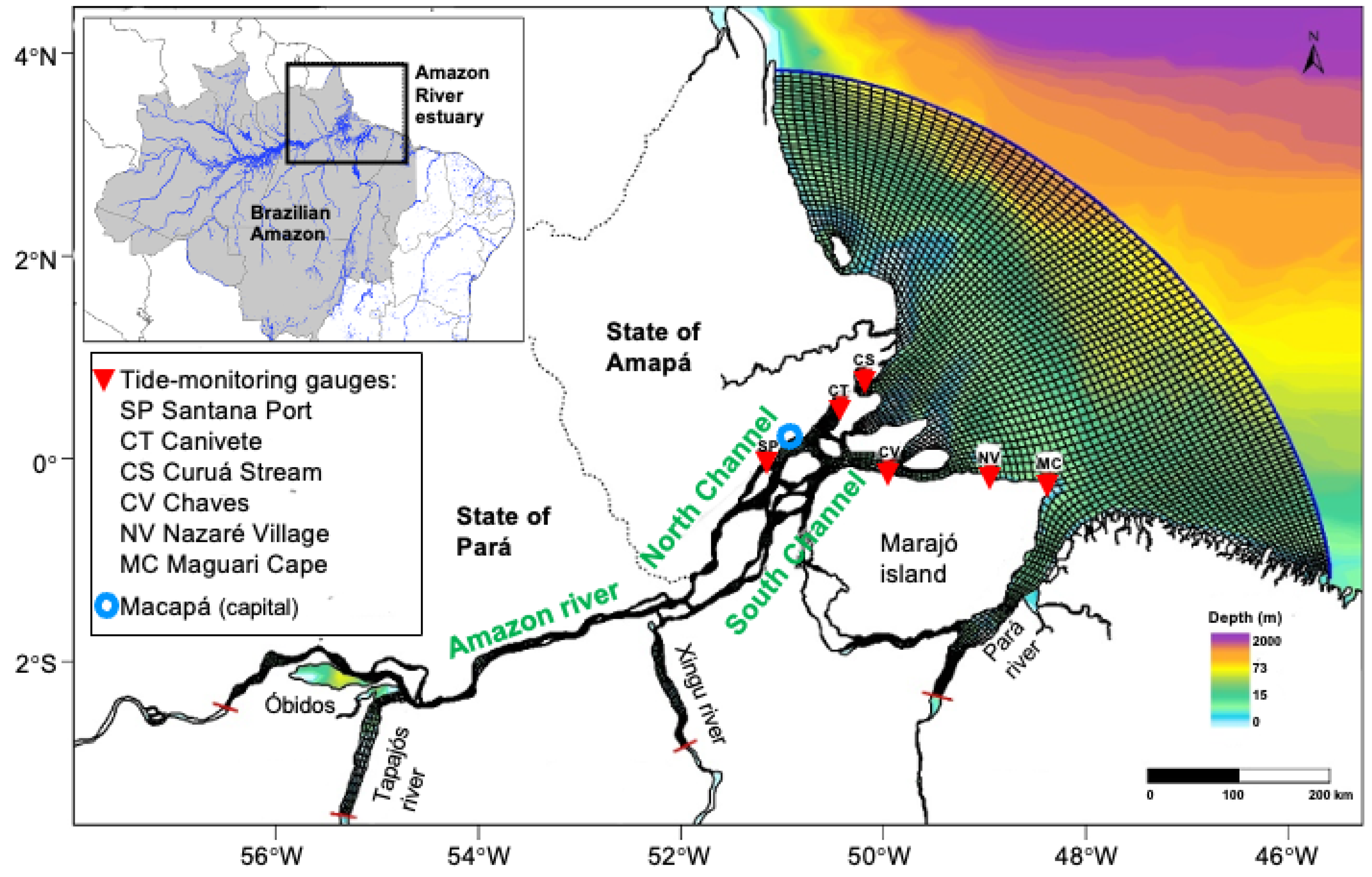
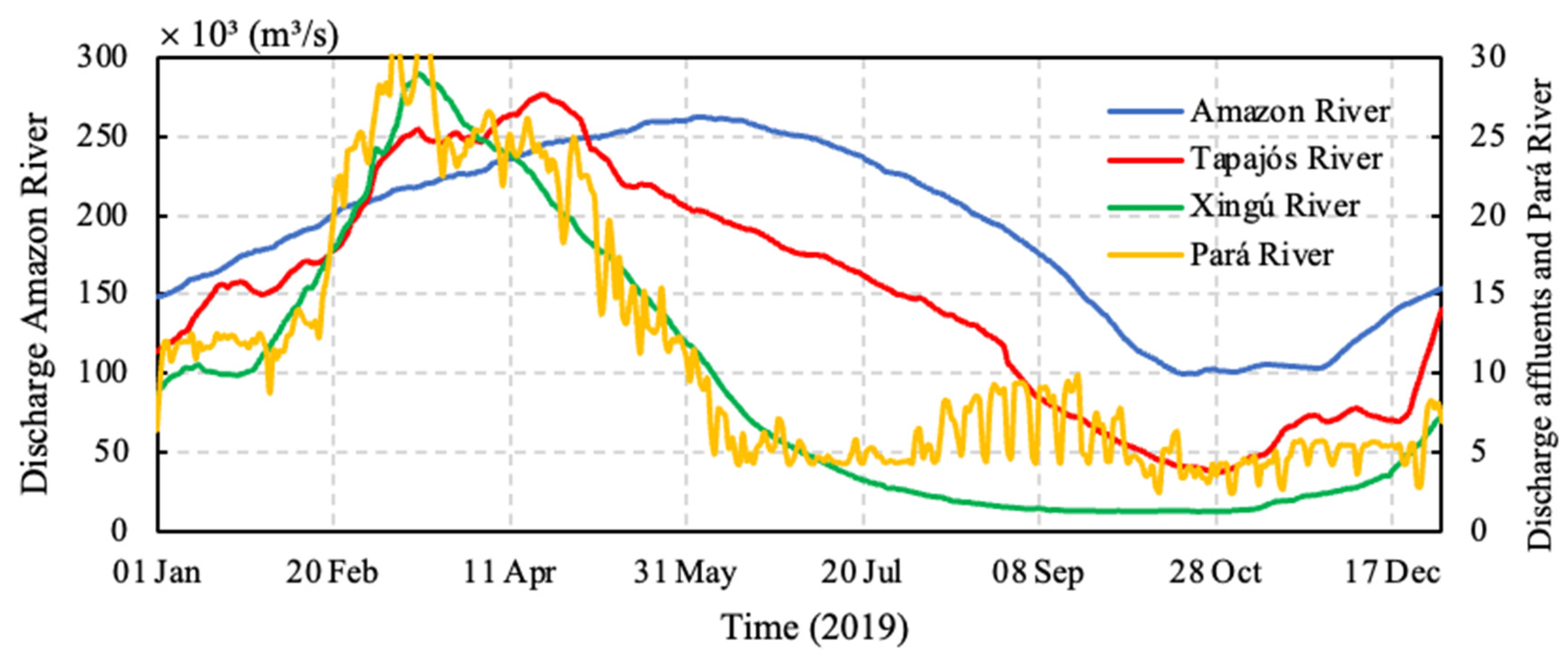
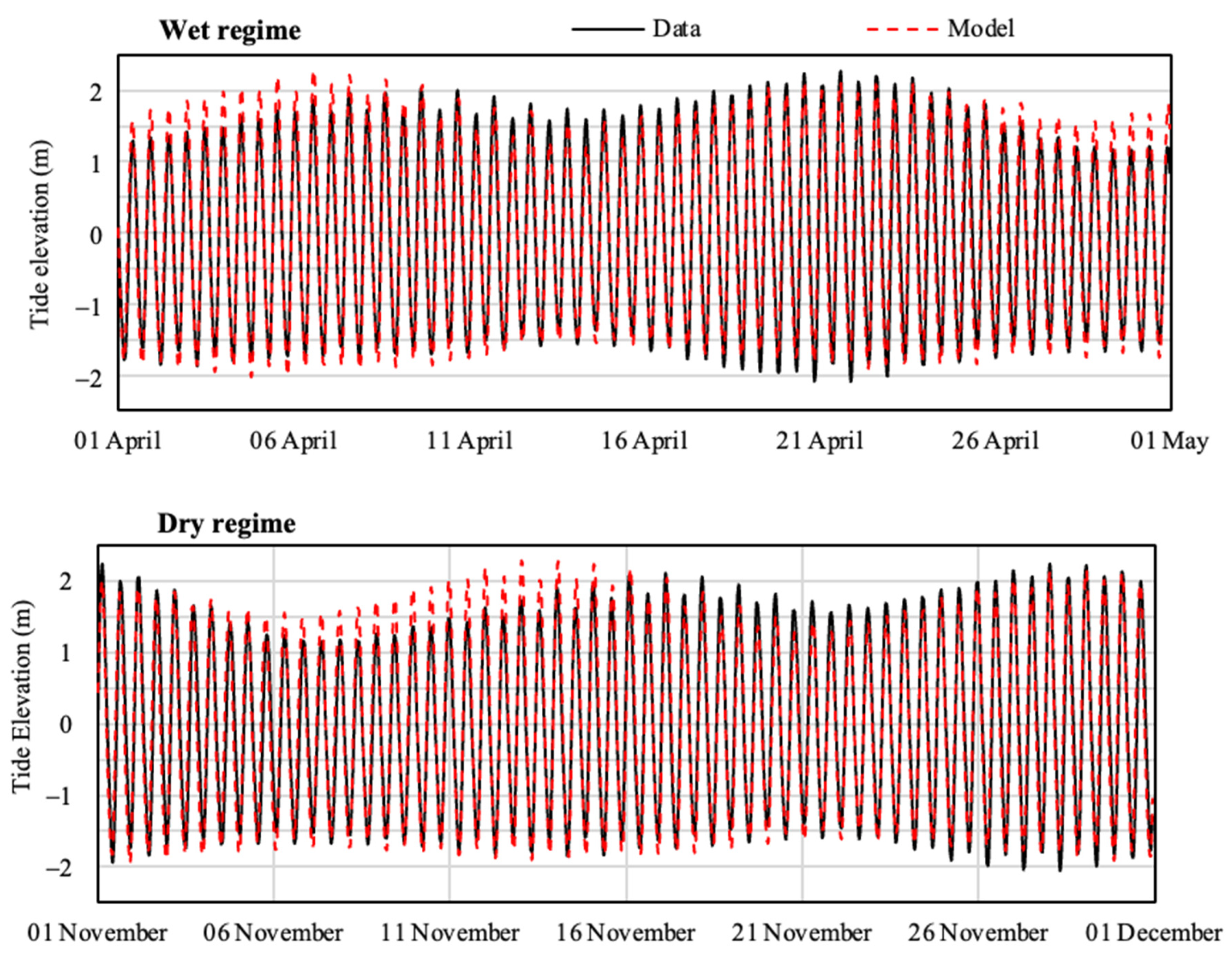

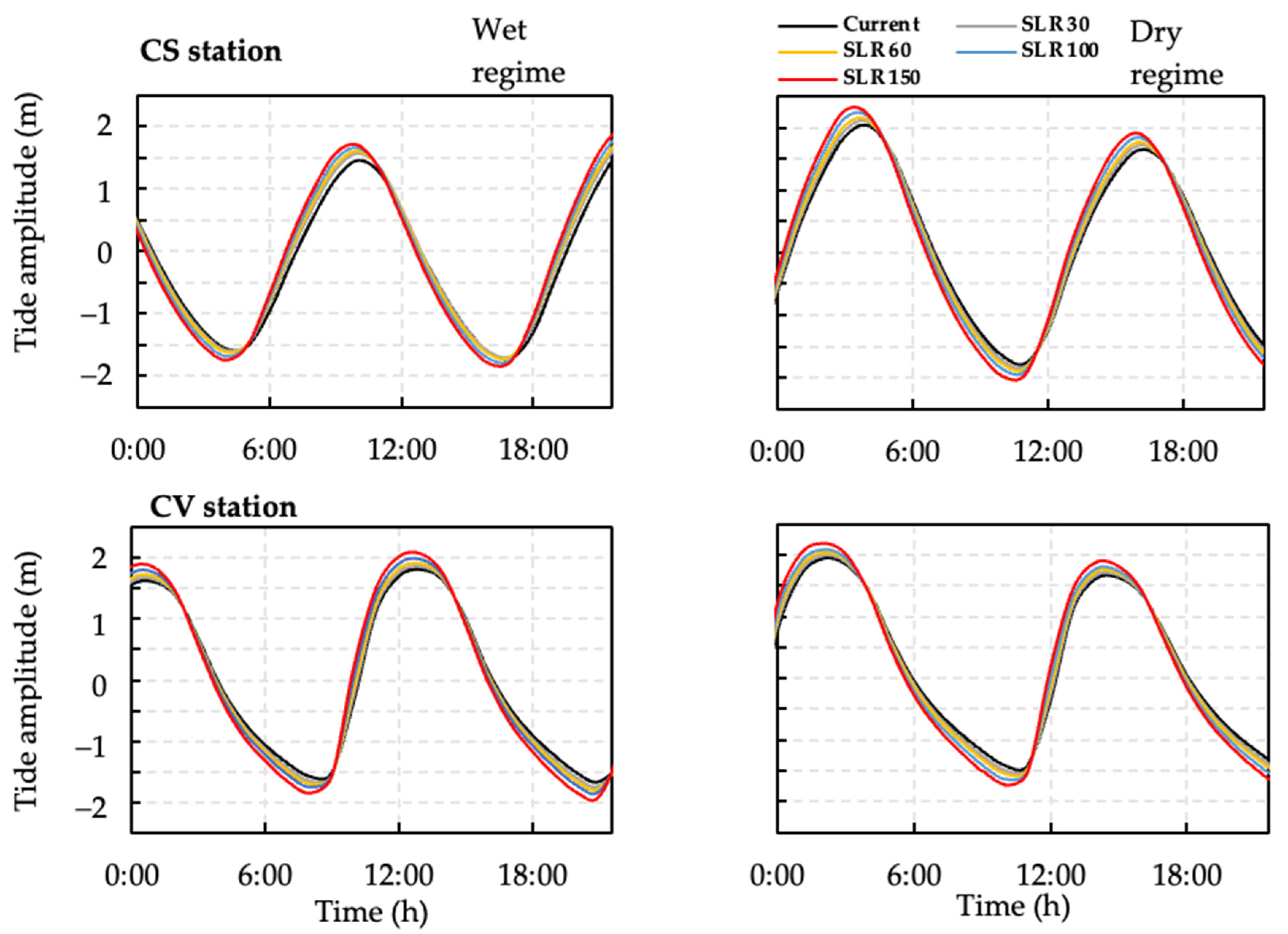
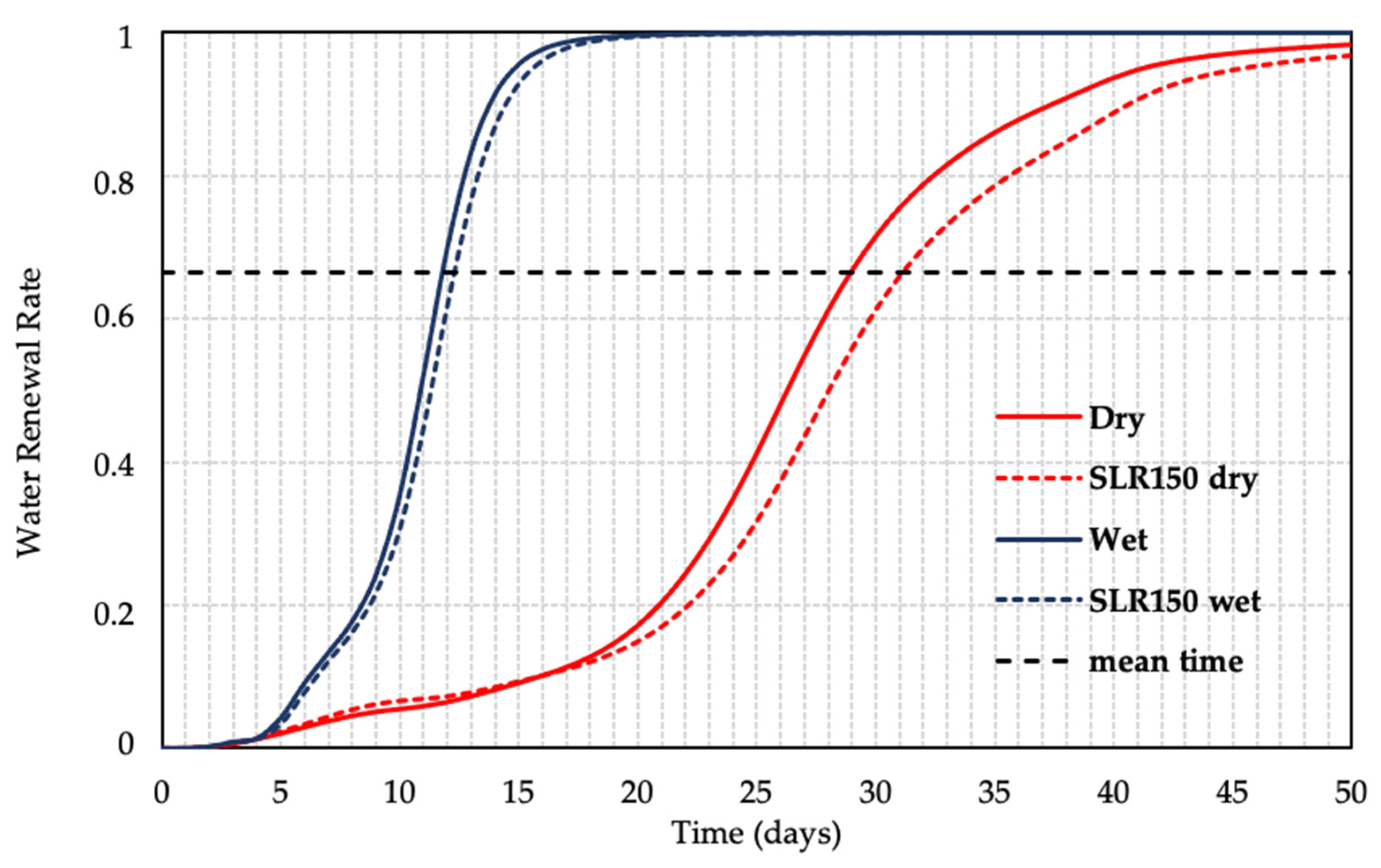

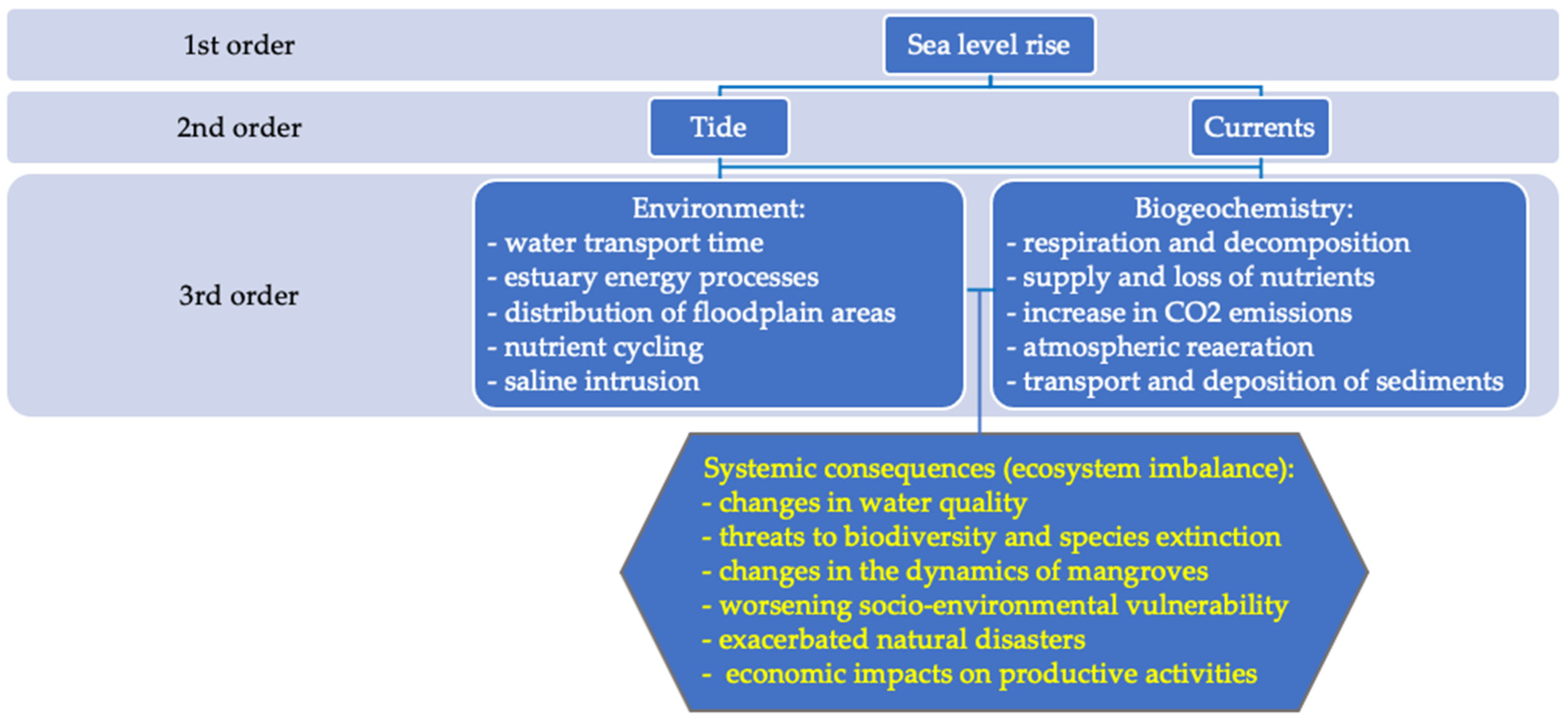
| Components 1 | Amplitude (cm) | Phase (°) | Description |
|---|---|---|---|
| K1 | 10.4 | 272 | Lunar/solar diurnal |
| O1 | 6.3 | 251 | Principal lunar diurnal |
| P1 | 3.4 | 272 | Principal solar diurnal |
| M2 | 152.7 | 315 | Principal lunar semidiurnal |
| S2 | 40.1 | 354 | Principal solar semidiurnal |
| N2 | 36.6 | 292 | Larger lunar elliptic semidiurnal |
| K2 | 10.9 | 354 | Lunar/solar semidiurnal |
| Station | Season | r2 | RMSE (m) | NSE | r | d |
|---|---|---|---|---|---|---|
| Cabo Maguari (MC) | Wet | 0.86 | 0.48 | 0.75 | 0.93 | 0.95 |
| Dry | 0.91 | 0.43 | 0.81 | 0.95 | 0.96 | |
| Curuá Stream (CS) | Wet | 0.93 | 0.32 | 0.92 | 0.96 | 0.98 |
| Dry | 0.92 | 0.37 | 0.90 | 0.96 | 0.97 | |
| Chaves (CV) | Wet | 0.89 | 0.38 | 0.81 | 0.94 | 0.96 |
| Dry | 0.92 | 0.34 | 0.85 | 0.96 | 0.96 | |
| Canivete (CT) | Wet | 0.86 | 0.33 | 0.84 | 0.92 | 0.96 |
| Dry | 0.91 | 0.31 | 0.89 | 0.95 | 0.97 | |
| Nazaré Village (NV) | Wet | 0.92 | 0.35 | 0.92 | 0.96 | 0.98 |
| Dry | 0.92 | 0.35 | 0.92 | 0.96 | 0.98 | |
| Santana Port (SP) | Wet | 0.72 | 0.46 | 0.73 | 0.87 | 0.90 |
| Dry | 0.74 | 0.44 | 0.73 | 0.86 | 0.90 |
Disclaimer/Publisher’s Note: The statements, opinions and data contained in all publications are solely those of the individual author(s) and contributor(s) and not of MDPI and/or the editor(s). MDPI and/or the editor(s) disclaim responsibility for any injury to people or property resulting from any ideas, methods, instructions or products referred to in the content. |
© 2024 by the authors. Licensee MDPI, Basel, Switzerland. This article is an open access article distributed under the terms and conditions of the Creative Commons Attribution (CC BY) license (https://creativecommons.org/licenses/by/4.0/).
Share and Cite
Crizanto, J.L.P.; de Abreu, C.H.M.; de Souza, E.B.; da Cunha, A.C. Modeling the Impacts of Sea Level Rise Scenarios on the Amazon River Estuary. Hydrology 2024, 11, 86. https://doi.org/10.3390/hydrology11060086
Crizanto JLP, de Abreu CHM, de Souza EB, da Cunha AC. Modeling the Impacts of Sea Level Rise Scenarios on the Amazon River Estuary. Hydrology. 2024; 11(6):86. https://doi.org/10.3390/hydrology11060086
Chicago/Turabian StyleCrizanto, Jonathan Luz P., Carlos Henrique M. de Abreu, Everaldo B. de Souza, and Alan C. da Cunha. 2024. "Modeling the Impacts of Sea Level Rise Scenarios on the Amazon River Estuary" Hydrology 11, no. 6: 86. https://doi.org/10.3390/hydrology11060086
APA StyleCrizanto, J. L. P., de Abreu, C. H. M., de Souza, E. B., & da Cunha, A. C. (2024). Modeling the Impacts of Sea Level Rise Scenarios on the Amazon River Estuary. Hydrology, 11(6), 86. https://doi.org/10.3390/hydrology11060086







